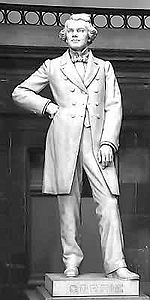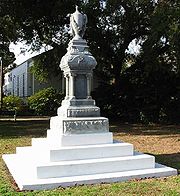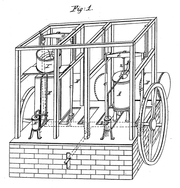
John Gorrie
Encyclopedia

Refrigeration
Refrigeration is a process in which work is done to move heat from one location to another. This work is traditionally done by mechanical work, but can also be done by magnetism, laser or other means...
and air conditioning
Air conditioning
An air conditioner is a home appliance, system, or mechanism designed to dehumidify and extract heat from an area. The cooling is done using a simple refrigeration cycle...
. He was born on the Island of Nevis
Nevis
Nevis is an island in the Caribbean Sea, located near the northern end of the Lesser Antilles archipelago, about 350 km east-southeast of Puerto Rico and 80 km west of Antigua. The 93 km² island is part of the inner arc of the Leeward Islands chain of the West Indies...
to Scottish
Scottish people
The Scottish people , or Scots, are a nation and ethnic group native to Scotland. Historically they emerged from an amalgamation of the Picts and Gaels, incorporating neighbouring Britons to the south as well as invading Germanic peoples such as the Anglo-Saxons and the Norse.In modern use,...
parents on October 3, 1802, and spent his childhood in South Carolina
South Carolina
South Carolina is a state in the Deep South of the United States that borders Georgia to the south, North Carolina to the north, and the Atlantic Ocean to the east. Originally part of the Province of Carolina, the Province of South Carolina was one of the 13 colonies that declared independence...
. He received his medical education at the College of Physicians and Surgeons of the Western District of New York
New York
New York is a state in the Northeastern region of the United States. It is the nation's third most populous state. New York is bordered by New Jersey and Pennsylvania to the south, and by Connecticut, Massachusetts and Vermont to the east...
in Fairfield, New York
New York
New York is a state in the Northeastern region of the United States. It is the nation's third most populous state. New York is bordered by New Jersey and Pennsylvania to the south, and by Connecticut, Massachusetts and Vermont to the east...
. In 1833, he moved to Apalachicola
Apalachicola, Florida
Apalachicola is a city in Franklin County, Florida, on US 98 about southwest of Tallahassee. The population was 2,334 at the 2000 census. The 2005 census estimated the city's population at 2,340...
, Florida
Florida
Florida is a state in the southeastern United States, located on the nation's Atlantic and Gulf coasts. It is bordered to the west by the Gulf of Mexico, to the north by Alabama and Georgia and to the east by the Atlantic Ocean. With a population of 18,801,310 as measured by the 2010 census, it...
, a port city on the Gulf
Gulf of Mexico
The Gulf of Mexico is a partially landlocked ocean basin largely surrounded by the North American continent and the island of Cuba. It is bounded on the northeast, north and northwest by the Gulf Coast of the United States, on the southwest and south by Mexico, and on the southeast by Cuba. In...
coast. As well as being resident physician at two hospitals, Gorrie was active in the community. At various times he served as a council member, Postmaster, President of the Bank of Pensacola's Apalachicola Branch, Secretary of the Masonic
Freemasonry
Freemasonry is a fraternal organisation that arose from obscure origins in the late 16th to early 17th century. Freemasonry now exists in various forms all over the world, with a membership estimated at around six million, including approximately 150,000 under the jurisdictions of the Grand Lodge...
Lodge, and was one of the founding vestrymen of Trinity Episcopal Church
Trinity Episcopal Church (Apalachicola, Florida)
Trinity Episcopal Church, originally known as Christ Church, is an historic house of worship in Apalachicola, Florida, United States, located at the corner of Avenue D and 6th Street . On June 30, 1972, it was added to the U.S. National Register of Historic Places.-National register...
.

Miasma theory of disease
The miasma theory held that diseases such as cholera, chlamydia or the Black Death were caused by a miasma , a noxious form of "bad air"....
was a prevalent hypothesis and based on this theory, he urged draining the swamps and the cooling of sickrooms. For this he cooled rooms with ice
Ice
Ice is water frozen into the solid state. Usually ice is the phase known as ice Ih, which is the most abundant of the varying solid phases on the Earth's surface. It can appear transparent or opaque bluish-white color, depending on the presence of impurities or air inclusions...
in a basin suspended from the ceiling. Cool air, being heavier, flowed down across the patient and through an opening near the floor. Since ice had to be brought by boat from the northern lakes, Gorrie experimented with making artificial ice.
After 1845, he gave up his medical practice to pursue refrigeration projects. On May 6, 1851, Gorrie was granted Patent
Patent
A patent is a form of intellectual property. It consists of a set of exclusive rights granted by a sovereign state to an inventor or their assignee for a limited period of time in exchange for the public disclosure of an invention....
No. 8080 for a machine to make ice. The original model of this machine and the scientific articles he wrote are at the Smithsonian Institution
Smithsonian Institution
The Smithsonian Institution is an educational and research institute and associated museum complex, administered and funded by the government of the United States and by funds from its endowment, contributions, and profits from its retail operations, concessions, licensing activities, and magazines...
. Impoverished, Gorrie sought to raise money to manufacture his machine, but the venture failed when his partner died. Humiliated by criticism, financially ruined, and his health broken, Gorrie died in seclusion on June 29, 1855. He is buried in Gorrie Square in Apalachicola.
According to Dr. Gorrie's biographer, Vivian M. Sherlock, the "Ice King", Frederic Tudor
Frederic Tudor
Frederic Tudor was known as Boston's "Ice King", and was the founder of the Tudor Ice Company. During the early 19th Century, he made a fortune shipping ice to the Caribbean, Europe, and even as far away as India from sources of fresh water ice in New England.The Tudor Ice Company harvested ice in...
, was suspected for causing his failure when he launched a smear campaign against the invention. Dr. Gorrie died impoverished in 1855 and the idea of air conditioning faded away for 50 years.
Monuments and memorials

- In Apalachicola, Gorrie Square is named in his honor. The square contains his grave site, a monument, the John Gorrie State MuseumJohn Gorrie State MuseumThe John Gorrie State Museum is a Florida State Park located in Apalachicola, a block off U.S. 98. It commemorates the man who was a pioneer in developing air conditioning, receiving the first U.S. Patent for mechanical refrigeration in 1851...
, and the Apalachicola Municipal Library. - The John Gorrie BridgeJohn Gorrie Memorial BridgeThe John Gorrie Bridge carries US 98 and US 319 over the Apalachicola Bay. It connects Apalachicola, Florida with Eastpoint, Florida. The original John Gorrie Bridge was built in 1935, replacing a ferry service between the two towns. It included a rotating section to allow passage of ships with...
across Apalachicola BayApalachicola BayApalachicola Bay is an estuary and lagoon located on Florida's northwest coast renowned for its oysters. The Apalachicola Bay system also includes St. Georges Sound, St. Vincent Sound and East Bay, covering an area of about . Four islands St. Vincent Island to the west, Cape St. George Island and St...
, connects Apalachicola with EastpointEastpoint, FloridaEastpoint is a census-designated place in Franklin County, Florida, United States. The population was 2,158 at the 2000 census.-Geography:Eastpoint is located at ....
. - In 1914, the state of Florida gave a statue of Gorrie to the National Statuary Hall CollectionNational Statuary Hall CollectionThe National Statuary Hall Collection in the United States Capitol comprises statues donated by individual states to honor persons notable in their history...
. - John Gorrie Junior High School in JacksonvilleJacksonville, FloridaJacksonville is the largest city in the U.S. state of Florida in terms of both population and land area, and the largest city by area in the contiguous United States. It is the county seat of Duval County, with which the city government consolidated in 1968...
and John Gorrie Elementary School in TampaTampa, FloridaTampa is a city in the U.S. state of Florida. It serves as the county seat for Hillsborough County. Tampa is located on the west coast of Florida. The population of Tampa in 2010 was 335,709....
are named in his honor. - The SS John Gorrie, a liberty shipLiberty shipLiberty ships were cargo ships built in the United States during World War II. Though British in conception, they were adapted by the U.S. as they were cheap and quick to build, and came to symbolize U.S. wartime industrial output. Based on vessels ordered by Britain to replace ships torpedoed by...
, was named in his honor. - The John Gorrie Award is awarded each year to a graduate of the University of Florida College of MedicineUniversity of Florida College of MedicineThe University of Florida College of Medicine is the medical school of the University of Florida. It is part of the J. Hillis Miller Health Science Center, with facilities in Gainesville and Jacksonville...
believed to be the “best all-around student showing promise of becoming a practitioner of the highest type.”

